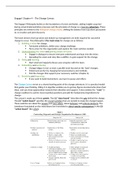Samenvatting
Summary Leading Change and Projects
- Instelling
- Vrije Universiteit Amsterdam (VU)
An extensive collection of academic articles and lectures relating to the concepts of Change Management and Project Management. Includes topics such as Change Leadership, Management Fashions, N-Step models, Change Capacity, Future Perfect Strategy, Work-Related Identity, Quantum Theory, the "Inner ...
[Meer zien]





